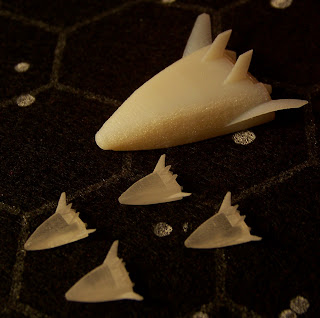The 3D print-on-demand service
Shapeways has been gaining popularity with miniature gamers, with many people trying out custom miniatures for very obscure or specialized subjects. I've always been interested in hard science fiction spacecraft, and some of the producers/sellers on Shapeways actually make them.
To try out the new technology and the subject, I ordered some spacecraft miniatures from a company called
Hobby Fuzion. Hobby Fuzion, run by a guy with the handle Grimjier, offers a line of miniatures from his Legend of Sol: Torch War universe. As far as I understand, this is sort of an alternate history universe where proposed 1950s/'60s space technology came to fruition, and the Cold War took place in space as well as on Earth. This means there are plenty of goodies from space geeks' fondest memories - Orion spacecraft, Dyna-Soar, etc. I ordered a few select miniatures from the line to see how well 3D-printed products look. Sorry for the quality of the photographs, but the translucent material of the miniatures made it hard to take them properly.

These are a couple of "MOL Corvettes". They seem to be made from the
Manned Orbiting Laboratory project's capsule module (the first 20mm or so of the model), with a long truss structure behind attached to thrusters. There are a couple of what appear to be radar dishes on the sides and a small launcher (for missiles?) on top. As you can see from the (rather blurry) close-up, the material is rather "rough", (and supposedly this is smoother than the non-translucent "white strong & flexible" material that's the default from Shapeways) and the 3D printing "layers" are visible. The truss structures on these models are also solid, with only shallow surface detail to show what they are. I guess at 42mm long, these miniatures are too small and thin to have real hollowed out structures. I will see how the surface texture looks after I've primed them with my usual Gesso.

Here are the backs of the same miniatures from above, showing the truss detail.

Next I have a couple of "Dyna-Soar NERVA" shuttles. The unfortunately named "Dyna-Soar" was a late '50s space plane design that was way ahead of its time. It was designed to be boosted into orbit on various types of rocket boosters, and was meant to fly back down like a plane, the same concept as the much later space shuttle. The booster on these models is the NERVA rocket, a later-abandoned nuclear thermal rocket design. These models are a much larger scale than the MOL Corvettes or the later Orion ships. The models measure approximately 32 mm long to the wing ends of the Dyna-Soar orbiter. This length in real life is supposed to be 10.77 m (it's a very small space plane). This makes for a ratio of 1/337 or so. Again, you can see the "grain" on the model from 3D printing.

The same model type, from the front and top this time.

And finally, the pi
èce de r
ésistance - the "Idaho class Orion frigate". The 1960s Orion spacecraft concept was simple, outrageous, and probably quite effective if ever carried out - you simply drop nuclear bombs behind you and let them blow you forward! Orion designs had the characteristic "pusher plate", the big circular dish at the end of the ship supported by piston-like "shock absorber" tubes, designed to take the brunt of the explosion and let physics do its work.
This spacecraft model combines the Orion design with some maneuvering thrusters near the front of the ship, along with a submarine-like sail that makes it look like a warped version of Khan's spaceship from the original Star Trek episode. There's also a delta-winged shuttle docked at the front of the ship. Using the shuttle's size, we can estimate the scale of the model. If the shuttle is Dyna-Soar sized, at 11mm that means the model is approximately 1:1000 scale. This means the 72 mm long model represents a 72 m long spacecraft. Another interpretation could be that the shuttle is actually more the size of a modern space shuttle, since the Dyna-Soar was rather small to have a top docking hatch like that. If for math convenience we assume the shuttle is actually 33m long (the space shuttle orbiter is ~37 m), that means the scale is more like 1:3000, similar to miniatures from games like Attack Vector: Tactical. This means the overall ship is a whopping 216 m long, a giant battleship.


Here are a couple more shots of the model from different angles, using less light so the detail is clearer. Again, we see the "layer"/grain problem, but this model is large enough that grain will be a small issue.

Here is a close-up of the pusher plate structure. 3D printing allows this sort of interior detail to be all done in one piece, unlike traditional metal or plastic models, where this would be very difficult, if not impossible.
So what to think? 3D printing is a very exciting technology, but you can tell with these miniatures that there's still quite a ways to go in the resolution department. I'll see how well the miniatures look once they are painted up.








































